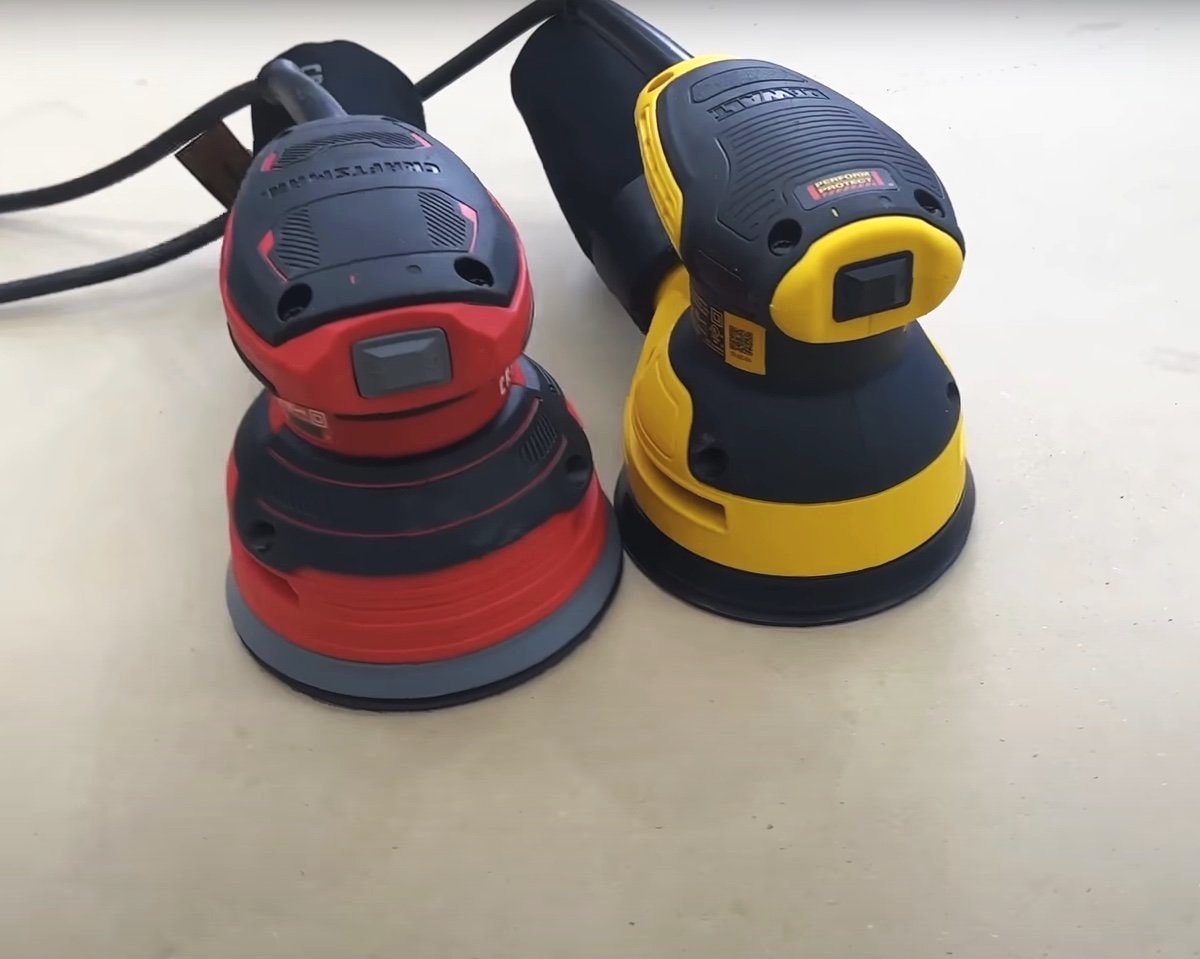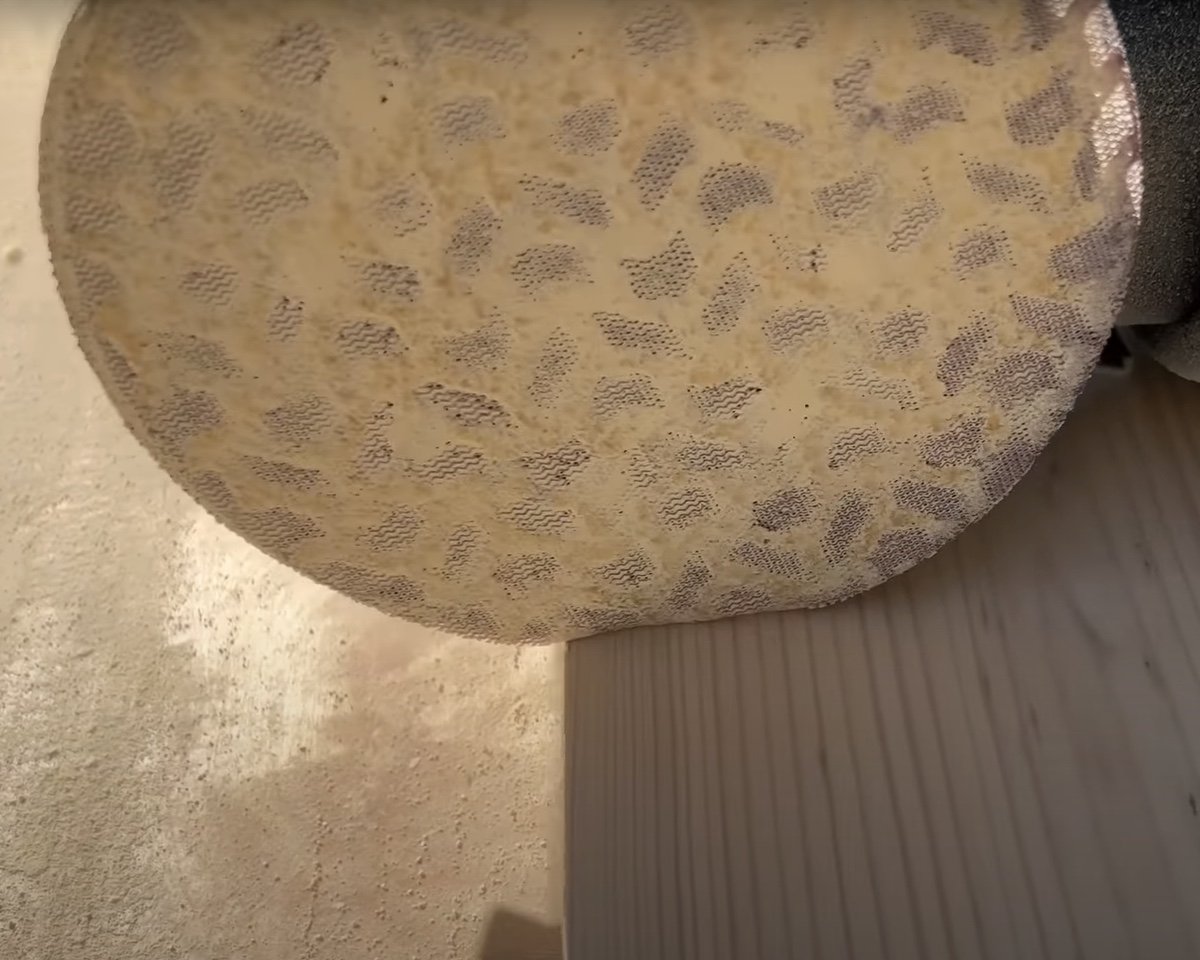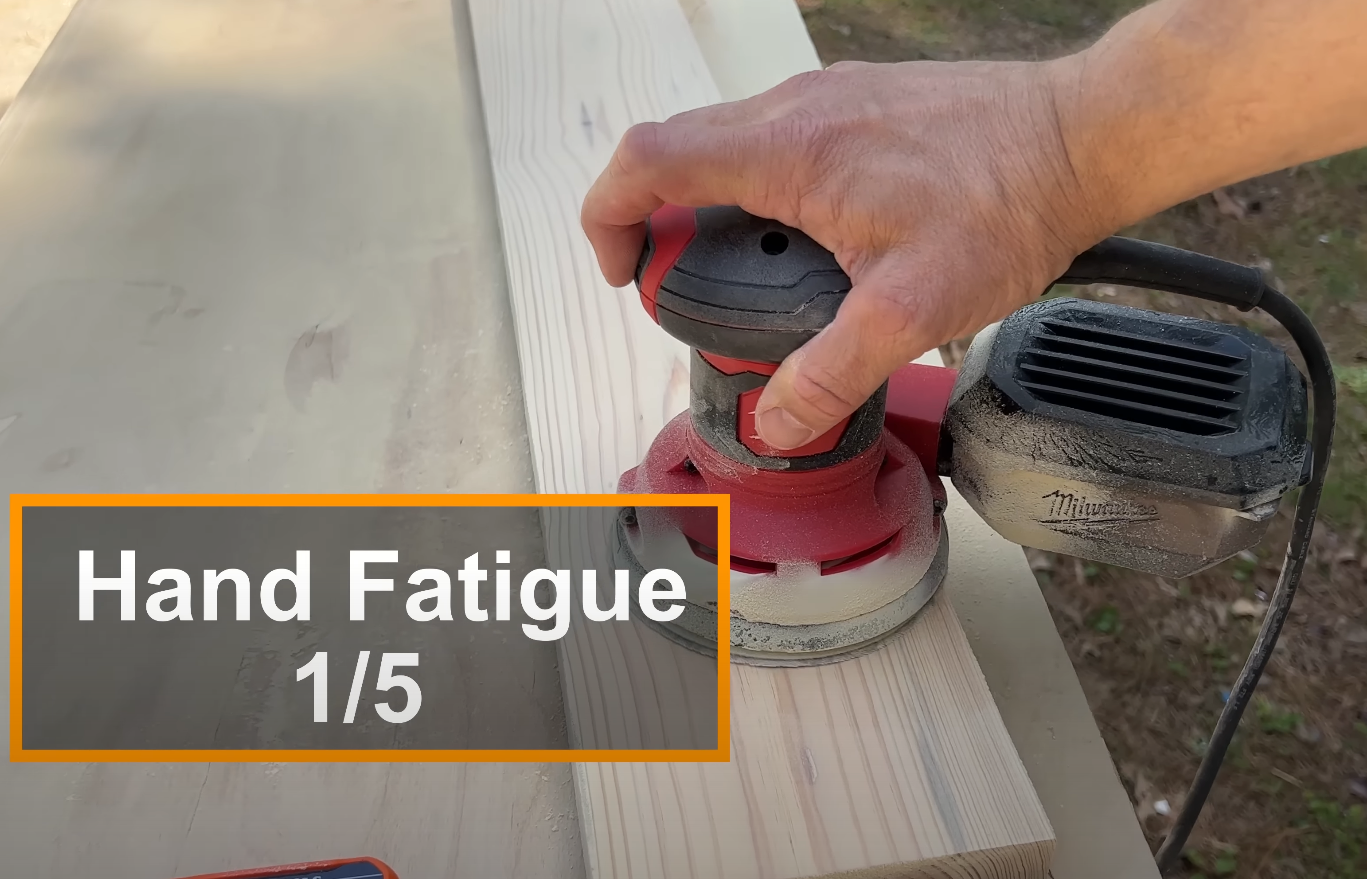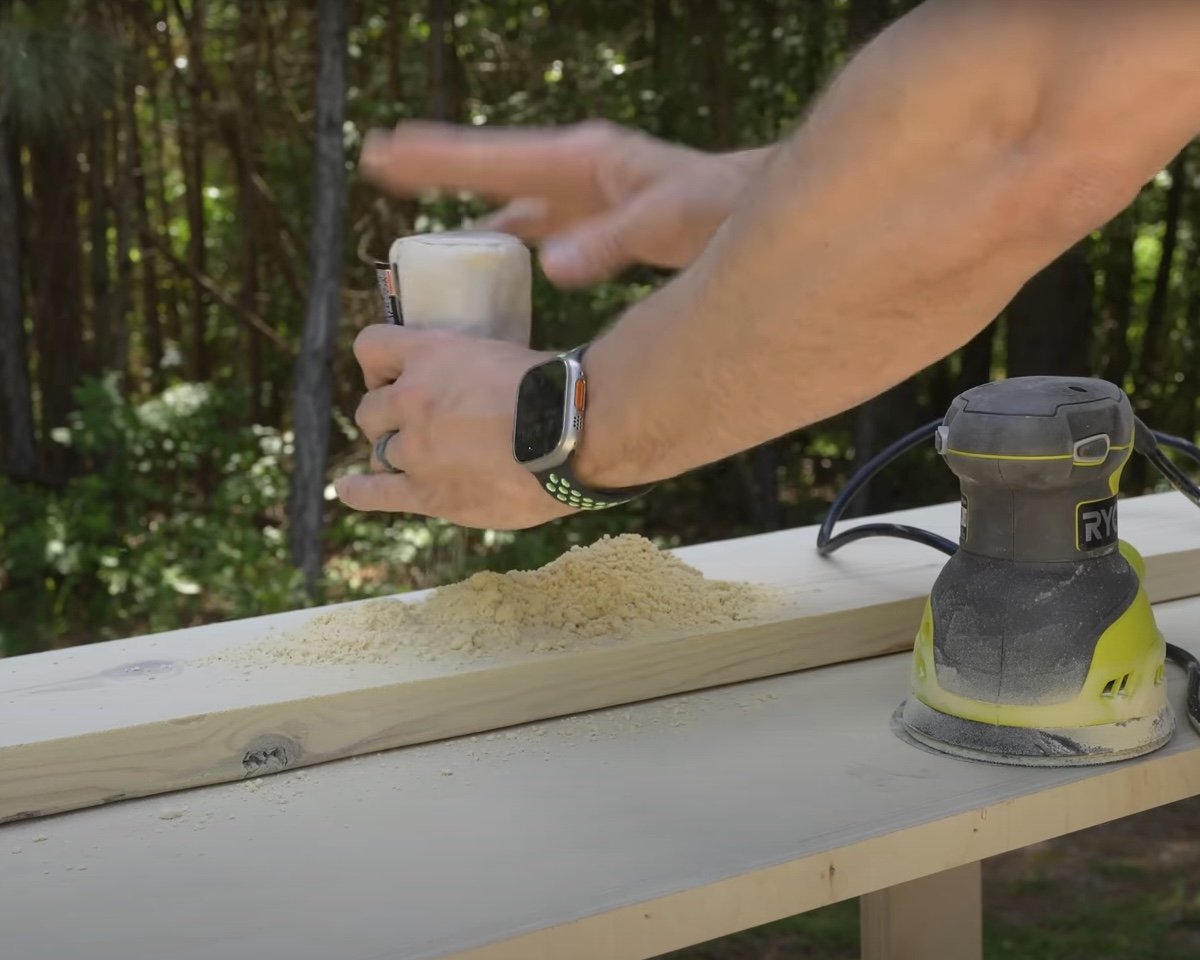Who Makes the Best Sander for Woodworking for Under $100
Best Random Orbital Sander Under $100
I bought 14 of the most common sanders that are under $100 from various brands. I put them through a series of tests to find out which one is the best for most people. I sanded with them, I checked to see how hot they got, I tested the vibration, and I tested their durability in case they fall off the workbench.
Links to each sander are listed along side their review below and a full list at the bottom of this post.
Affiliate links are used on this website to help support the website. For more information, read our affiliate disclaimer. This review was not sponsored. I purchased every sander myself.
TLDR
Best sander for most people -
Top Pick: DeWALT https://amzn.to/45wD0i8
Also a good options: Milwaukee Orbital Sander - https://thetoolnut.sjv.io/WqYKQM
Budget Pick: Craftsman - https://amzn.to/3IJI09d
Who makes the best orbital sander under $100?
The only three brands that came with a bag or some type of carrying case are the Ridgid, one style of Makita, and also the Milwaukee. When I bought it, the Makita with the handle was under $100, but as of filing of the review video it was up to $108. I kept it in the review group though.
For size and weight, the WEN is pretty heavy, as well as the Makita with the handle. The heaviest sander was the Hercules. It’s well-balanced, but it is quite heavy, which may be a benefit once we start sanding with it. Also on the heavier end are the Ridgid, the Bosch, and the Skil. The others in the test all pretty much weigh the same.
A lot of times when you’re in Harbor Freight, you’ll see the Hercules brand and they’ll say, “Compare this to the DeWALT version of XYZ”. They compare themselves to DeWALT a lot. And the two sanders do look kind of similar, but they’re actually not.
Craftsman and DeWALT share the same dust bag connection, same overall design.
Craftsman vs DeWALT sanders appear to be the same thing.
The Craftsman does look identical to the DeWALT, so much so that I would make a bet that they come out of the same factory. The only thing that’s different is DeWALT has variable speed and Craftsman does not. They both come with 3-year warranties. The Craftsman is about $54, and the DeWALT is about $84. From what I can tell, all you’re getting for that $30 is the variable speed. They both weighed the same, both have the same motor (3 amps) and same stroke rate (~ 3/32”).
Interesting First Impressions – The Metabo has a 12’ power cord, but the dust bag goes on weird. It clips on to the top, and it pops off very easily. The Hercules has a 10’ power cord, and the gauge of the cord itself is much thinner than the others. It’s very heavy, but that weight may absorb some vibration. There’s almost no vibration in my hand, and it’s very quiet.
The one thing I wasn’t impressed with on the Skil was the plastic dust collection box. It’s going to break, and I would almost put money on it that in the drop test, it breaks. I would prefer the little bags. It is quiet though, and there’s very little vibration. It almost feels underpowered.
One of the most popular sanders is the Bosch, so I’m very curious to see how it performs. I’ve never used it before. I’ve always used Festool or the DeWALT (or Hyper Tough, if you go way back). There is a significant amount of vibration in my hands, and it has a high-pitched grinding sound inside when it’s on. This will be interesting to use.
Where They’re Made – The Bauer, Black & Decker, Bosch, Hercules, Metabo, Milwaukee, Skil, and WEN are all made in China. Craftsman and DeWALT are both made in Mexico. Both of the Makitas are made in Japan. The Ridgid is made in Vietnam, and the Ryobi is made in Thailand.
Hook and Loop Test – I first tested these by putting sandpaper on them straight out of the box, then pulled the paper off. I used both Festool’s granat and Cubitron paper because they both stick a little differently. I’ll present these sanders as Good – Better – Best.
On the Good list, the Metabo, Ridgid, the cheaper of the two Makitas, and the Milwaukee all had mediocre hook-and-loop sticking power at best.
The Better options were the WEN, the Bosch, the handle Makita, and also the Bauer. They all did pretty well as far as holding the paper.
Now, for the Best options, I had to put a little force on all of them to get the paper off. We’re looking at the Skil, the Hercules, the Ryobi, the Black & Decker, the DeWALT, and of course its brother, the Craftsman.
Sanding Test – I took all the sanders and sanded with them for fifteen minutes each. Do that on 14 different sanders, and that’s a whole lot of time sanding. I alternated hands with each one, and I spread it out over two days just to make sure my hands weren’t too fatigued. I used the stock dust collection, the bags that came with each one, just to see how they would each perform under normal circumstances. I also have a thermal imager to see how hot each one gets around the sanding area, as well as around the hand area.
I rated the vibration of each sander on a scale of 1 to 5.
During this test I’m going to rate the hand fatigue on a scale of 1 to 5 based on the numbness I feel in my hand and my lower arm. 5 will be the worst extreme, meaning it’s the most numb, and it hurts, with 1 being the best.
Bauer https://sovrn.co/12cj588 – The first thing I noticed about the Bauer is that it’s extremely underpowered. If you put any pressure down, it just stops spinning and vibrates. Only one of the other sanders did this. The dust collection I would rate as fairly poor, and the sanding pad was clogged up at the end of that fifteen minutes. The temperature got up to 101.6 º, which wasn’t too hot but still not the coldest in the group. For hand fatigue, I rated it a 3. It wasn’t really bad, but it wasn’t really great either. In the drop test, after just a few drops the dust container cracked, which is just the nature of the beast when you put a plastic container on something that’s inevitably going to fall off of a workbench.
Bauer orbital sander dust collection broke during the drop test.
Bauer Orbital sander does have a noticeable amount of vibration when sanding causing some hand fatigue.
Black & Decker https://amzn.to/438WCax – The Black & Decker reached a temperature of 110.2 º. This is one of the hotter sanders. It had a very disappointing performance overall and felt very weak. The hand fatigue was at a 4/5. There’s a lot of vibration in there, which will cause fatigue. The on-board dust collection is very good on this sander, though. It collected most of the dust, and the sanding pad stayed relatively clean. After the drop test, there was zero damage that I could tell. There was a little bit of road rash, but everything still functioned fine.
Black & Decker Dust Collection was good
Bosch https://amzn.to/3oxc3do – The Bosch got up to 129.1 º, which made it one of the hotter sanders. Heat is the enemy of sanding, so your sanding disc won’t last as long. I also found the Bosch to be very underpowered, especially on initial start-up. It didn’t want to spin. Honestly, the Bosch was probably the most disappointing tool in this line-up, largely because my overall opinion of the tool company was that they are better than this. The hand fatigue was light, coming in at a 2/5. The on-board dust collection was very poor. It even stopped up the sanding disc. Despite having a similar plastic dust collection container as the Bauer, it performed better in the drop test. Nothing cracked or broke. The top did pop off, but it popped right back on.
Bosch Sander gets hot during use.
Bosch Orbital Sander dust collection is very poor.
Craftsman https://amzn.to/3oqOSlf – The Craftsman got up to 105.0 º during testing, which overall wasn’t that bad, but it also wasn’t the greatest. The hand fatigue was about a 2/5. I didn’t feel a whole lot of numbness when I was done, and I was pretty impressed. In all, it performed very similarly to the DeWALT.
DeWALT https://amzn.to/43tsjLj – The DeWALT did get a little hotter at 114.2º. The hand fatigue was similar to the Craftsman. The on-board dust collection on both I would rate as fair, though both will perform better when hooked up to a dust extractor. Though I will say at the end of the fifteen minutes, the paper on the Craftsman was clogged up, whereas the DeWALT was clean. In the drop test both sanders were very beefy and showed only a very little bit of road rash. I’ve personally dropped the DeWALT sander multiple times in my shop with no issues. I even broke a sink one time when the sander fell off the workbench. The collar on the Craftsman dust bag did come apart in the drop test, but unless you lost the bearing that holds the bag in place, you can reassemble it pretty easily.
DeWALT Orbital Sander Dust Collection is very good.
Hercules https://sovrn.co/dc48uyt – Even though the Hercules isn’t the heaviest of the group, it just feels like a heavy sander. It got up to 129.2º, which made it the hottest out of the whole group. It had a harsh hand fatigue at 4/5, but probably could have crept up into 5 had I kept on using it. It has a lot of vibration. It’s also very aggressive, meaning it’s very hard to control. The on-board dust collection is very poor, and the entire sandpaper was clogged up after fifteen minutes. Some of that could be attributed to the heat, as it’s so hot it’s also baking that sawdust into the sandpaper. I should point out that I used new Cubitron paper on each sander, so the clogged paper on the Hercules was its own doing. It performed well in the drop test, still working after dropping. As heavy as it is, it was like dropping a brick.
Hercules Orbital Sander gets very hot during use.
Harbor Freight’s Hercules Sander has a lot of heat which causes the sawdust to bake onto the sanding disc.
Makita, with the front handle https://amzn.to/45ABV8O – The sander with both the rear and front handle was the only sander in the group that kept shocking me. It happened when I was holding it by the back handle, and it was consistent. When I held it by the top it was perfectly fine. The heat came in at 107º. The hand fatigue came in at a 2/5. It absorbed the vibration well. The on-board dust collection performed well. The sanding disc was a little clogged after fifteen minutes, but some of that could be attributed to heat. The worst offender was that shocking handle, and it was a significant shock, not just a little tingle. I expected something to break in the drop test because of the handle sticking out, but it absorbed the impact well, and it’s still working.
Makita sander dust collection performed well.
I like the two handle design of this Makita sander
Makita, no extra handle https://amzn.to/3BXZ6wp – It got up to 111.3º, and that heat showed on the sanding disc. The pad was completely clogged over, and the heat is a big factor there. The hand fatigue here was a 3/5 because I did start to feel a little bit of numbness. The dust collection here was fair. It did collect a good bit of dust in the bag, but not as much as I would like due to the stopped-up disc. In the drop test, it performed just as well as the other Makita.
Unfortunately the “no handle” Makita sander didn’t perform well. The disc gets clogged easily.
Metabo https://amzn.to/43oH8zr – The Metabo got up to 107.7º, and I had very little hand fatigue at 2/5. The dust collection on this thing was very poor. The sanding disc was completely clogged, and I can’t hate this dust bag more. It pops off way too easily. In the drop test, every time you bump this thing the stupid bag flies off.
I can’t hate the way this Metabo Sander’s dust bag attaches. It comes off very easily and you can’t adapt that to a shop vac easily.
Milwaukee Buy here: https://thetoolnut.sjv.io/WqYKQM – The Milwaukee did get fairly hot at 119.7º, but it didn’t bake onto the sanding pad, and it had very good dust collection. I consider this to be the best of the bunch as far as dust collection goes. After fifteen minutes, there was very little dust collected on the sanding disc. It also had the best hand fatigue out of all at 1/5, which really surprised me based on my initial impressions out of the box. In the drop test, other than the top of the dust box popping off and dust going everywhere, it fared well. Overall, it’s a better plastic than was on the Bosch, but I’m not a fan of these plastic containers.
Minimal vibration in the hand from the Milwaukee Random Orbital Sander
Milwaukee Orbital Sander has very good dust collection.
Ridgid – https://homedepot.sjv.io/VmOKdO It didn’t get overly hot, coming in at only 97.4º. Hand fatigue was a 2/5, and wasn’t bad at all. The on-board dust collection was pretty good, and the sanding disc wasn’t stopped up at all after fifteen minutes. After the drop test, it didn’t sustain any damage.
Ridgid Random Orbital Sander performed well during the drop test.
Ryobi https://homedepot.sjv.io/B059ky – Unsurprisingly, Ryobi performed very similarly to the Ridgid since they both come from TTI. It got up to 97.7º. The hand fatigue was quite a bit worse at 4/5 after fifteen minutes. However, the dust collection was pretty good, very similar to the Ridgid. The sanding disc was clean after fifteen minutes. Also similar to the Ridgid, it performed well in the drop test, sustaining no damage.
Ryobi orbital sander performed well in dust collection but left me lacking in other areas.
Skil https://amzn.to/3IKisZA – The Skil got up to 118.5º, with a mediocre hand fatigue at 3/5. The dust collection was very bad on this sander. While sanding, a lot of the dust was airborne and on my hand, and not going into the plastic canister. The bags allow for airflow, which is how they end up working so well. This canister was airtight, which doesn’t work well in my opinion. The canister fell off while sanding, and during the drop test it broke to the point where it won’t go back on correctly.
Poor performance all around with the Skil sander.
Not a fan of the plastic dust box on the Skil sander.
WEN https://amzn.to/42ciDUm – The WEN got up to 104.3º, and the hand fatigue was the worst out of all the sanders. I rated it at a 5/5, and my hand was extremely numb. It also had the worst dust collection out of any of them. The dust was basically pushed up through the filter and going airborne. The way the dust canister connects is a proprietary design, so there’s no way to hook up a shop vac. During the drop test, the canister actually broke on either the first or second drop. It’s just not an overall performer, and I’m typically a fan of WEN tools.
WEN Orbital sander didn’t survive the drop tests.
Connecting to a dust extractor – I wanted to see how much of a difference was made in performance by being hooked up to a dust extractor. I tested this by connecting my Festool extractor to the Bosch since it was one of the hotter ones at 129º after fifteen minutes. I sanded with it again for another fifteen minutes using the dust extractor.
Connecting a sander to a dust extractor makes a huge difference in heat build up, sanding disc life, as well as dust collection.
The temperature reading this time read 102.3º, so that’s a 27-degree drop. Other than a little build-up on one edge of the sanding pad, the dust extractor also kept the sanding pad very clean. Any of these sanders will likely benefit from the dust extractor or shop vac connection, other than the few that have a square connection. For those, you’ll have to find an adapter. They are available, but it’s just going to be more trouble.
Performance data from these tests for each sander (according to me).
Worst-to-First Rankings – We may have some differing opinions based on these results. This is not a knock against your brand, this is just my personal experience, and how I feel about them after using them.
In the Worst category, I was really surprised by three of the sanders that ended up here. The long-handled Makita has to go at the back of the line bec ause of the way it was shocking me. The other Makita is back there as well because of how bad that dust collection is. The tiny port is going to be difficult adapting that to a shop vac. The WEN and the Skil both broke on drops after not really performing well to begin with. The Ryobi has so much hand fatigue that I can’t recommend it. The Bosch was so disappointing just because of all the good things I’ve heard about it, but it was the most underpowered. Hercules and Bauer also ended up here because of poor performance and poor dust collection. They also have proprietary dust connections, which will make it difficult to adapt.
There were two middle-of-the-road picks, the Ridgid and the Black & Decker. The only drawback to the Black & Decker, in my opinion, is that hand fatigue. It is significant. Otherwise, it performs well, and I’ve used for a little while in the shop. It is a good budget pick, and the only reason it’s in the middle-of-the-road is that hand fatigue. The Ridgid performed well. It’s a variable-speed sander, it collected the dust well, and it’s overall a decent choice. The price of $79, when compared to the performance, is why I put it in the middle.
I picked three that I felt belonged in the Best category for most people. One is a budget option, and the other two are “buy once, cry once” upper-end picks. The Milwaukee performed extremely well and is probably one of the better performing sanders. It is one of the more expensive sanders, though, at around $89. One thing that put it over the top for me was that they do include an adapter for connecting to a dust extractor. It’s also a variable-speed, it performed well overall, it had the best dust collection, and it had the best hand fatigue.
Milwaukee includes a dust hose adapter with this sander.
I think the DeWALT Random Orbital Sander is the best sander under $100 for most people!
The Craftsman orbital sander is my pick for a budget sander that performs very well overall.
The Craftsman and the DeWALT are basically the same sander, except the DeWALT has the variable-speed. The DeWALT is actually the one I would recommend to most people because of all the features it has, the standard-sized dust extraction, and it performed well in the test. When you hook up the DeWALT and Craftsman to dust extraction, they both work really well, and they hold up well over time. I’ve had a DeWALT one for many, many years. If you are on a bit of a budget, or you don’t care about the variable speed, the Craftsman is the way to go.
If budget is not a concern and you want the best finish sander in my opinion then, I highly recommend the Festool ETS125. I’ve had this sander for nearly two years now and paired with a Festool Dust extractor like the CT36, it’s an amazing combo for your woodworking shop. Full review on those two here: https://youtu.be/ifVesG68MWI
Best Sander under $100 for Most People:
DeWALT - https://amzn.to/3ovMfOZ
Craftsman - https://amzn.to/3oDKYFp
Milwaukee - https://thetoolnut.sjv.io/eKRBPz
If you have the budget, this is my top pick over $100: https://amzn.to/3IMWyoD
You can watch the full sander review video review here - https://youtu.be/9C4gZA-XxTc































